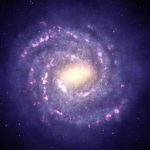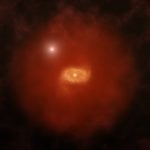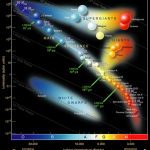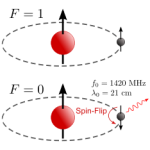Glossary of Radio Astronomy Terms
H I Region:
A region in space, seen as cloud-like features, containing mostly neutral atomic hydrogen gas. If it is of sufficient density, this region may become the birthplace of stars and planets.

H II Region:
A region in space around one or more very hot, bright stars where most of the hydrogen gas is ionized.
Halo:
The spherical region of a spiral galaxy composed of diffuse gas (diluted interstellar material and contains few stars and star clusters.

Heliosphere:
The region around the Sun and Solar System that is maintained by the solar wind given off by the Sun. The solar wind creates a bubble like effect in the interstellar medium in which our Solar System resides.

H-R Diagram (Hertzsprung-Russell Diagram):
The diagram is used by astronomers to classify stars by their their luminosity, spectral type, color, temperature and evolutionary stage. Most stars fall into the Main Sequence part of the diagram, which runs from upper left, where stars are hot and luminous, to the lower right, where stars are cool and faintly luminous. (See below for more on the Main Sequence)

Hertz:
A unit of measurement of a wave’s frequency. Hertz are measured by the number of oscillations that occur per second. 1 Hertz (Hz) = 1 cycle or oscillation/second.
Hubble Constant (H):
A measure of the rate of expansion of the Universe. Current estimates say that our universe is expanding at about 70 km/s/megaparsec (Kilometers per second per megaparsec).
21-cm Hydrogen Line:
Radio emission by a neutral hydrogen atom when its electron flips its spin. This causes the electron to emit a single photon with a wavelength of 21 centimeters.







